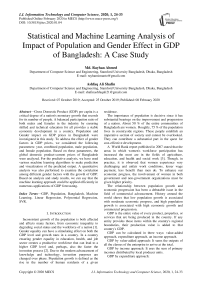Statistical and Machine Learning Analysis of Impact of Population and Gender Effect in GDP of Bangladesh: A Case Study
Автор: Rayhan Ahmed, Ashfaq Ali Shafin
Журнал: International Journal of Information Technology and Computer Science @ijitcs
Статья в выпуске: 1 Vol. 12, 2020 года.
Бесплатный доступ
Gross Domestic Product (GDP) per capita is a critical degree of a nation's monetary growth that records for its number of people. A balanced participation ratio of both males and females in the industry by ensuring skilled and technical education for all provides a stable economic development in a country. Population and Gender impact on GDP prices in Bangladesh were investigated in this study. To address the effect of gender factors in GDP prices, we considered the following parameters: year, combined population, male population, and female population. Based on these parameters, the global domestic product-current prices of Bangladesh were analyzed. For the predictive analysis, we have used various machine learning algorithms to make prediction and visualization of the predicted output. A quantitative analysis was also performed to examine the correlation among different gender factors with the growth of GDP. Based on analysis and study results, we can say that the machine learning approach could be applied efficiently in numerous applications of GDP forecasting.
GDP, Population, Bangladesh, Machine Learning, Linear Regression, Polynomial Regression, SVR
Короткий адрес: https://sciup.org/15017100
IDR: 15017100 | DOI: 10.5815/ijitcs.2020.01.04
Список литературы Statistical and Machine Learning Analysis of Impact of Population and Gender Effect in GDP of Bangladesh: A Case Study
- Peterson, E. Wesley F. “The Role of Population in Economic Growth.” SAGE Open, Oct. 2017, doi:10.1177/2158244017736094.
- Löfström, Åsa. "Gender equality, economic growth, and employment." Swedish Ministry of Integration and Gender Equality (2009).
- "Whispers to Voices: Gender and Social Transformation in Bangladesh" (PDF). Bangladesh Development Series, Paper No. 22. Washington, D.C.: The World Bank. p. 57.
- Alquier, P., & Li, X. (2012, October). “Prediction of quantiles by statistical learning and application to GDP forecasting.” International Conference on Discovery Science (pp. 22-36). Springer, Berlin, Heidelberg.
- Linhua Feng, Jianzhen Zhang, “Application of artificial neural networks in tendency forecasting of economic growth.” Economic Modelling 40 (2014) 76-80.
- Libor Krkoska, Utku Teksoz, “Accuracy of GDP growth forecast for transitions countries: Ten years of forecasting assessed.” International Journal of Forecasting 23 (2007) 29-45.
- Theodore Modis, “Long Term GDP forecast and prospects for growth.” Technological Forecasting & Social Change 80 (2013) 1557 – 1562.
- Hastie T., Tibshirani, R., Friedman, J., & Franklin, J. “The elements of statistical learning: data mining, inference, and prediction.” The Mathematical Intelligencer (2005), 27(2), 83-85.
- Nardi, Peter M. “Doing survey research: A guide to quantitative methods.” Routledge, 2018.
- Ross, A., & Willson, V. L “Paired samples T-test. Basic and advanced statistical tests.” (2017). (pp. 17-19). Brill Sense.
- Levine, Timothy R., et al. "A critical assessment of null hypothesis significance testing in quantitative communication research." Human Communication Research 34.2 (2008): 171-187.
- Narula, Subhash C., and John F. Wellington. "Prediction, linear regression, and the minimum sum of relative errors." Technometrics 19.2 (1977): 185-190.
- Ostertagová, Eva. "Modelling using polynomial regression." Procedia Engineering 48 (2012): 500-506.
- Basak, Debasish, Srimanta Pal, and Dipak Chandra Patranabis. "Support vector regression." Neural Information Processing-Letters and Reviews 11.10 (2007):203-224.
- Yang, Haiqin, et al. "Localized support vector regression for time series prediction." Neurocomputing 72.10-12 (2009): 2659-2669.


